Saint Martin
“Saint Martin or Sint Maarten? French frolic or Dutch debauchery? In a region of island contrasts this one takes some beating. Forts, cruise ship hordes, duty-free shopping, casinos, condos, resorts, nightlife &, of course, the world-famous & unrivaled aviation thrill of the island’s Maho Beach, the most intimate plane-spotting location on planet earth.“
image || A welcome party on Maho Beach, Sint Maarten, Lesser Antilles, West Indies. June 8 2015.
Saint Martin
A spur-of-the-moment flight booking to a neighbouring island when in the presence of a US Immigration official in Puerto Rico‘s Luis Muñoz Marín International Airport some 9 days prior granted me access to that particular Caribbean charm. Utilising said flight found me in the rather bizarre half-Dutch, half-French Lesser Antilles territory of Saint Martin, and in a region of island contrasts this one takes some beating. It’s one small Caribbean Island with two vastly different outlooks – French frolic or Dutch debauchery? Take your pick. Or just sample them both. The northern French side – Saint-Martin – is (much) more sedate, more laid-back Caribbean, but it’s the southern Dutch side – Sint Maarten – where you’ll probably have more fun, definitely see more people and most likely spend more money; this is where you’ll find a cruise terminal, duty-free shopping, casinos, condos, sprawling resorts, thumping nightlife &, of course, the world-famous & unrivaled aviation adventure served up by the island’s Juliana Airport & Maho Beach (trust me, you’ve seen photos before). Yes, welcome to Saint Martin, probably the best & definitely the most intimate plane-spotting location on planet earth. Don’t forget your sun cream, hair gel or ear plugs.
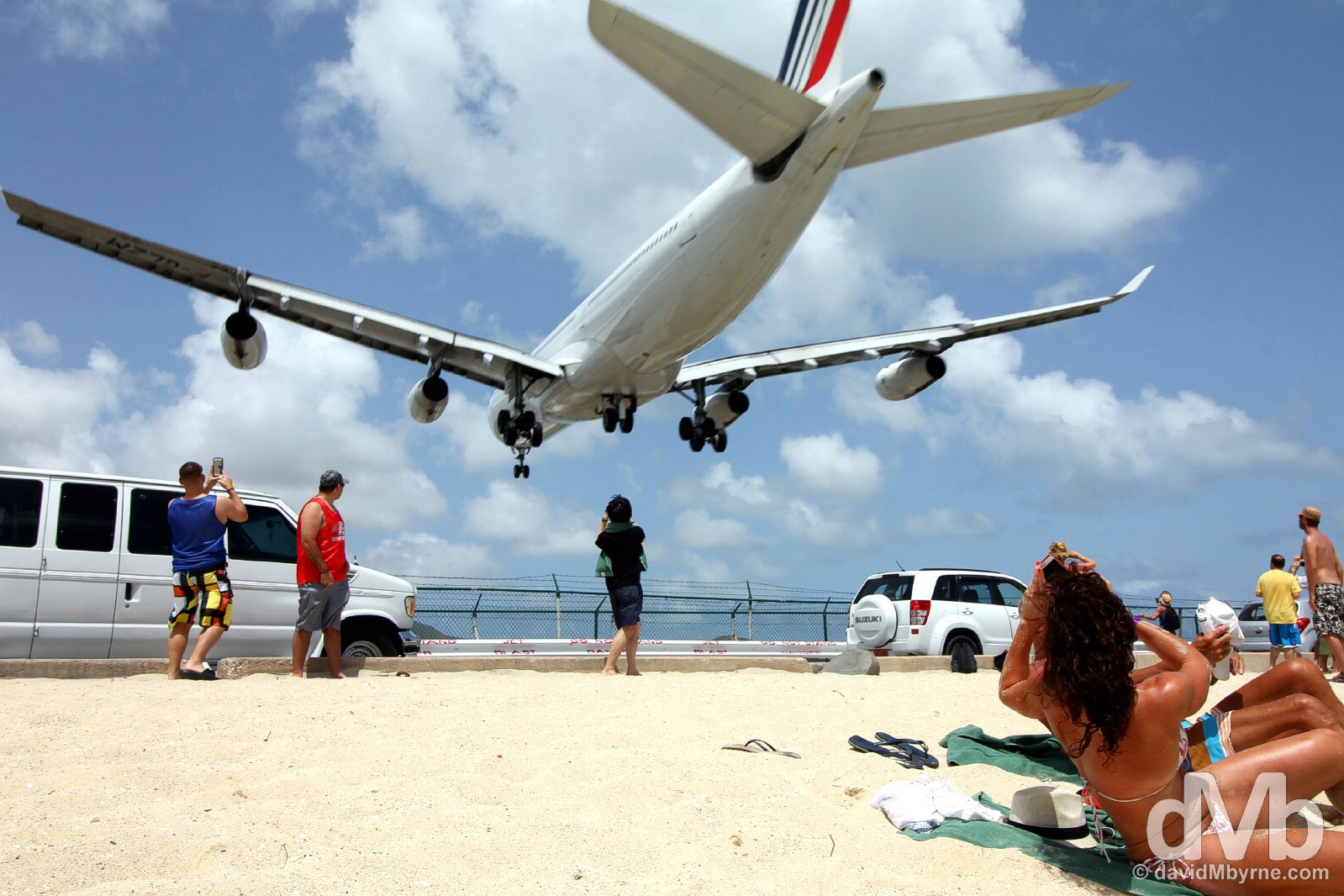
Disturbing the sunbathing. An Air France A340 landing at Princess Juliana International Airport over the sands of Maho Beach, Maho Bay, Sint Maarten, Lesser Antilles. June 8, 2015.
HISTORY & THE DIVISION
This is yet another regional piece of land that, and although he never set foot on the island itself, was claimed for Spain in late 1493 by Columbus on his second voyage to the New World; he named it Isla de San Martín after Saint Martin of Tours because it was 11 November, St. Martin’s Day. The Spanish didn’t value the island initially and settlements by the Dutch, English & French went unchallenged. That was until they – the Spanish – seized complete control of the island in 1633, then seeing it as valuable in maintaining control of the salt trade. Subsequent years saw the Spanish rebuffing Dutch attempts to capture the island, one the Spanish finally realised, in 1648, wasn’t actually worth holding onto and thus abandoned for good. With the island free again, both the Dutch and the French jumped at the chance to re-establish their settlements. To avoid war they decided to share it as per the Treaty of Concordia, an arrangement that still stands to this day and one that makes this the smallest inhabited island in the world divided between two nations. The invisible border has changed many times over the years but today French Saint-Martin claims 61% of the island (53 km²) to Dutch Sint Maarten‘s 39% (34 km²). But, and as previously noted, it’s the Dutch, with the larger population occupying the smaller space, that make the most noise and seem to have the lion’s share of the fun in the Caribbean sun.
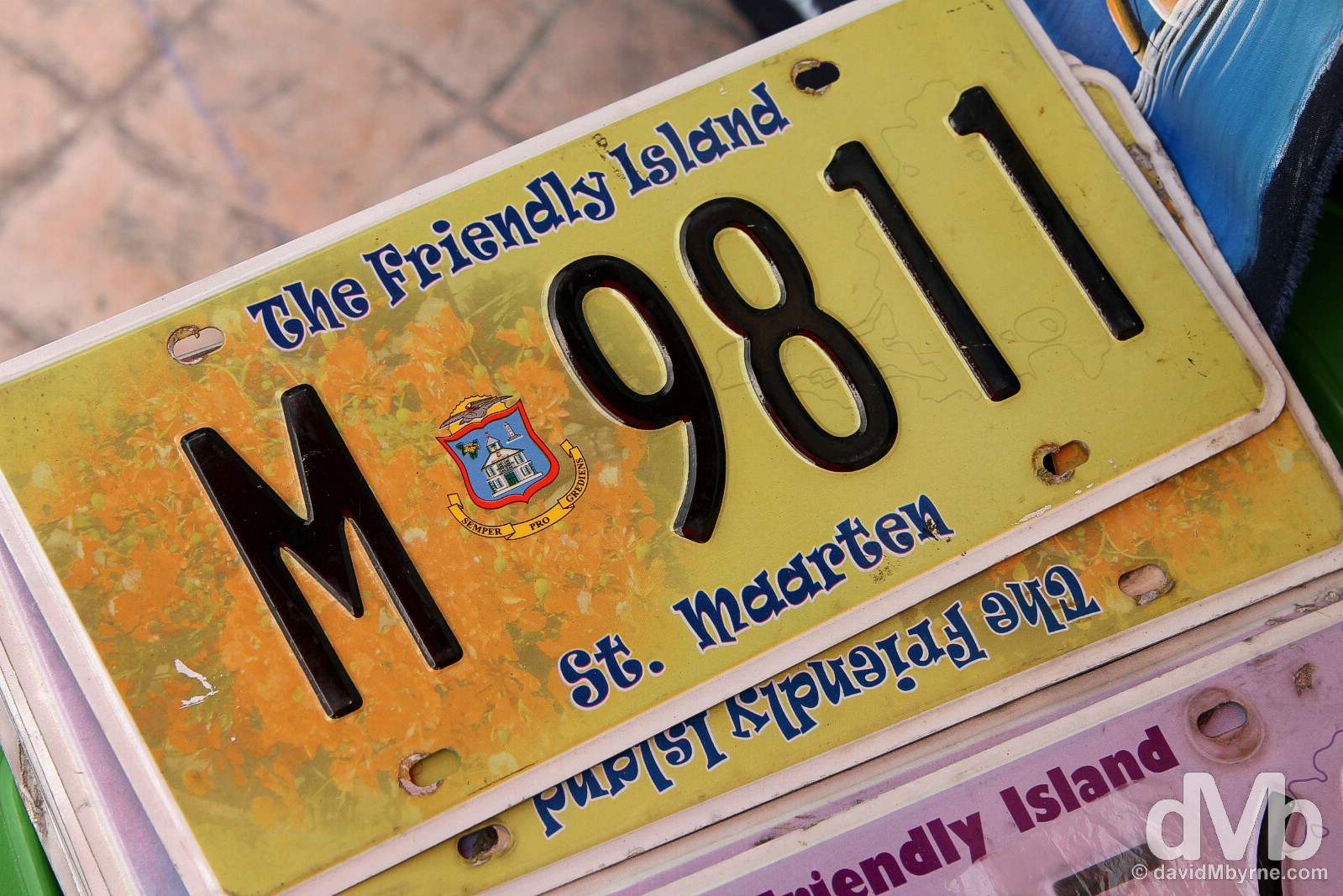
The Friendly Island. Philipsburg, Sint Maarten, Lesser Antilles. June 9, 2015.
Saint-Martin – The French Side
I stayed on the Dutch side. I ate on the Dutch side. I drank on the Dutch side. But I visited the French side, getting the public minibus the short distance (6 kilometres) from my base beside Juliana Airport to the Saint Martin capital of Marigot.
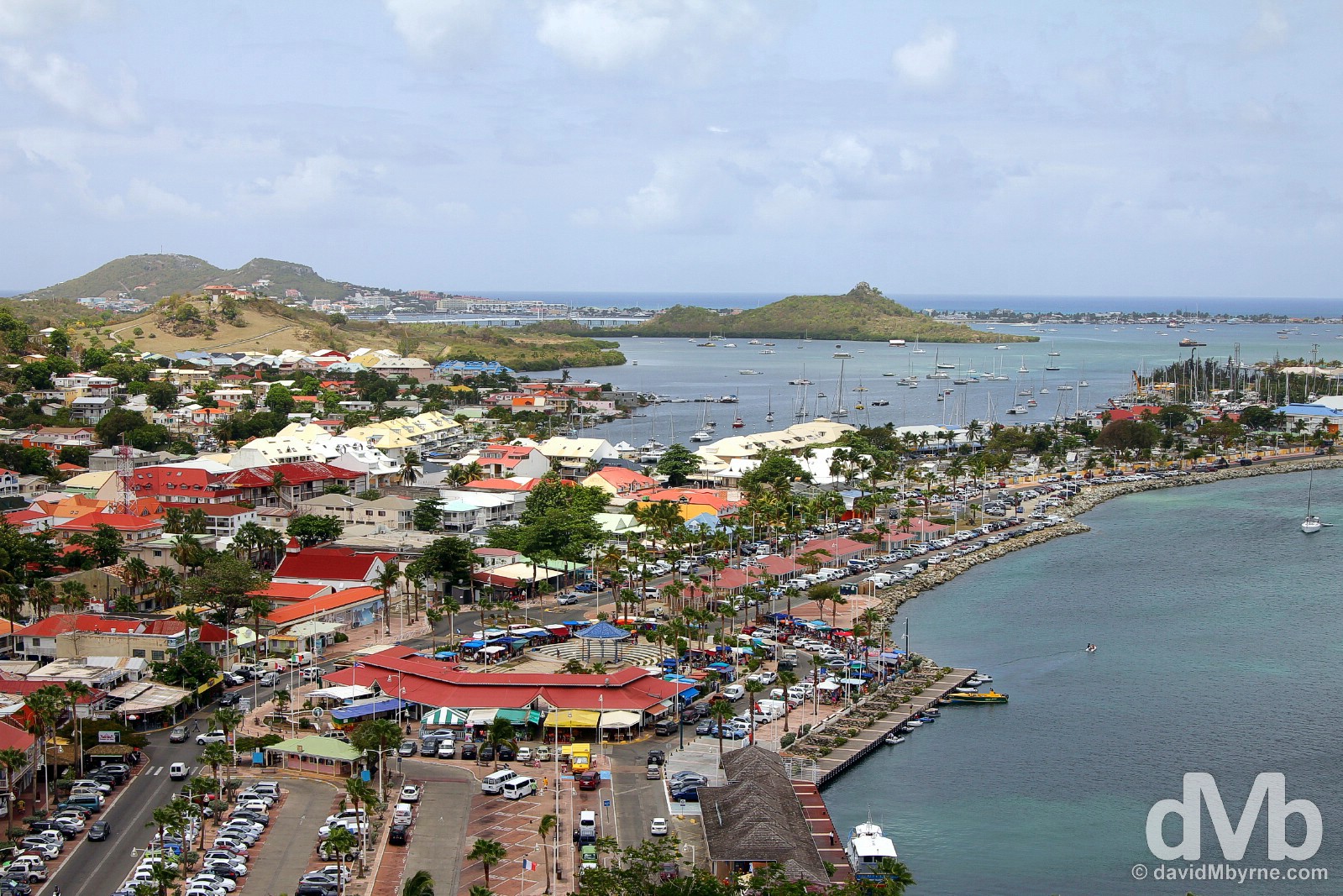
Marigot as seen from Fort Louis, Saint-Martin, Lesser Antilles. June 8, 2015.
It’s a pretty place, Marigot, although there’s not a whole lot to see or do so it won’t detain a visitor for long. The port town boasts a ferry service to the nearby British colony of Anguilla, the cheapest way of getting from this particular Caribbean island to one of the West Indies most exclusive & expensive islands; a few resident drunks in the small central park (I couldn’t help but comment that this would be a nice place in which to be destitute); a colourful array of tourist-tat stalls in the Waterfront Market; a few nice & typically Caribbean wooden buildings with wrought-iron balconies; and a grouping of large ‘I Love SXM’ letters just begging to be photographed and shared on social media. I saw them all en route to the town’s Fort Louis, but not before I had me some lunch.
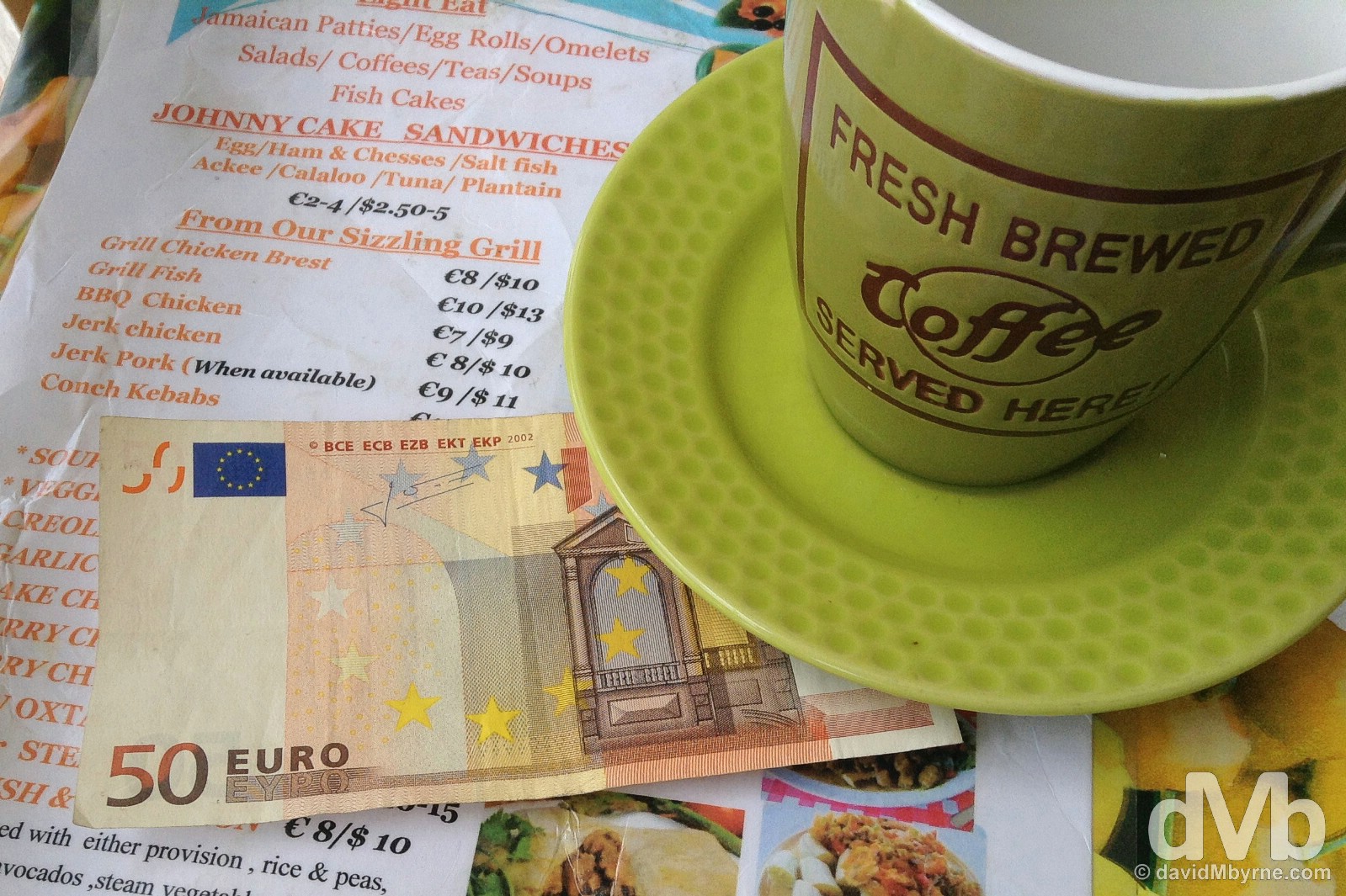
Euroland? Yes, but no. Your money’s no good here. Part of my Saint-Martin thrill was having Euros in my pocket again. The only problem was the lady in the cafe visibly flinched at my production of a €50 note, preferring payment in $USD for my Johnny Cake Sandwich & coffee. Damn. I was looking forward to being back in Europe while physically being in the Lesser Antilles. Marigot, Saint-Martin, Lesser Antilles. June 8, 2015.
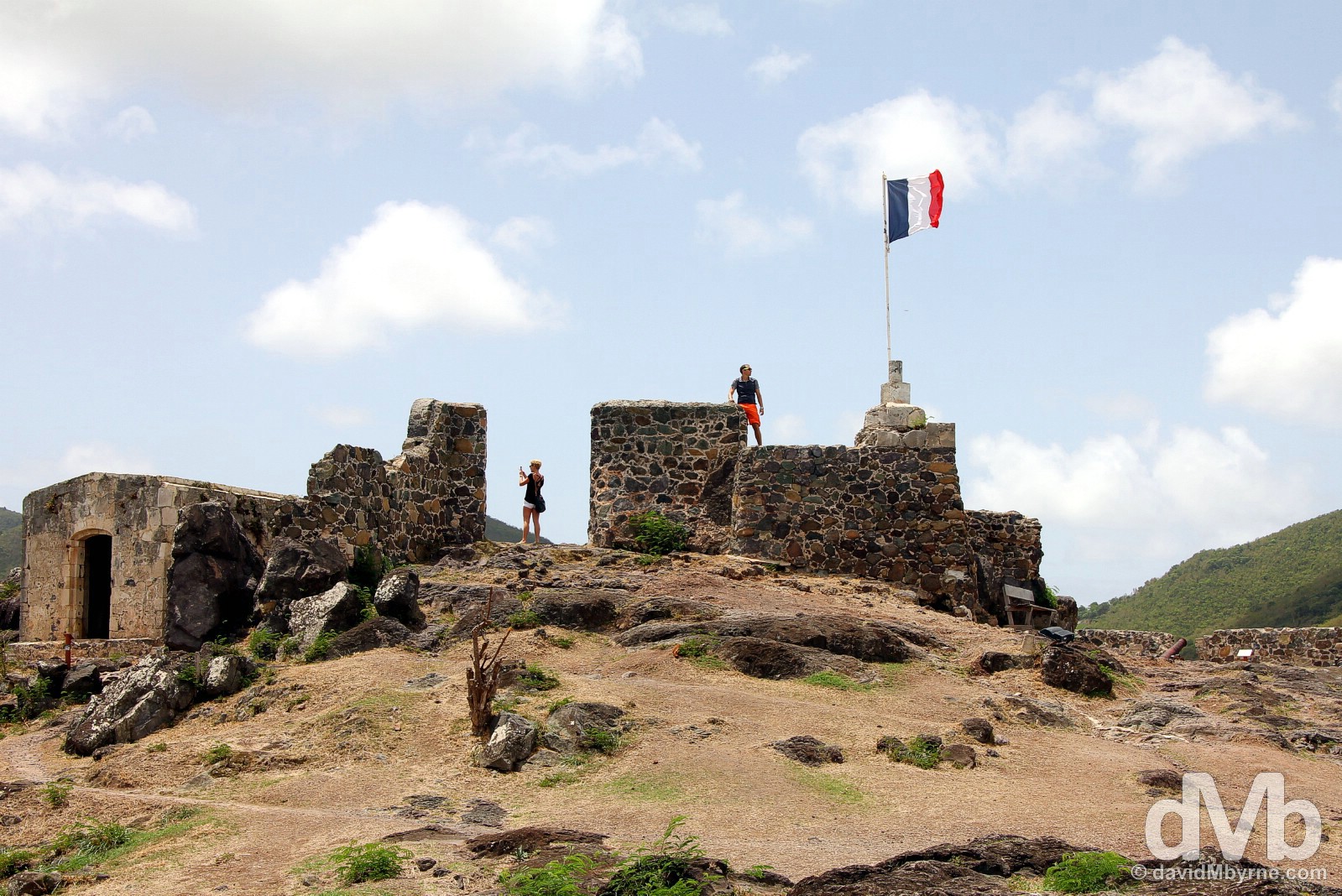
The French tricolour flies above Marigot’s only bona fide attraction, Fort Louis perched on Marigot Hill overlooking the town. It was constructed in 1789 to protect the town from the constant scourge of marauding British & Dutch pirates (placards at the foot of Marigot Hill detail British incursions with no reference to the Dutch ones. Don’t antagonise the neighbours I guess). The fort has been abandoned for centuries and today its stumpy stone walls are refuge for a few rusting cannons pointing in all directions. Marigot, Saint-Martin, Lesser Antilles. June 8, 2015.
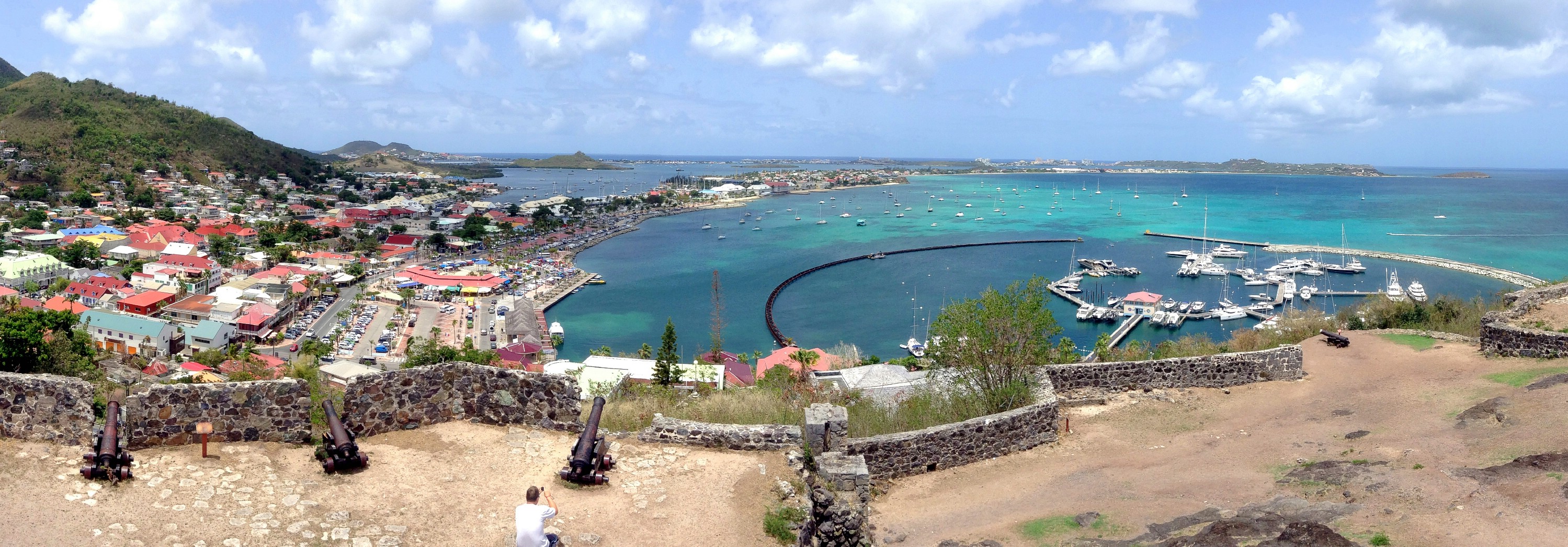
Easily the highlight of a visit to Fort Louis fort is the view it affords down over the town and the wider southern portion of the island (it’s not quite as picturesque looking north). Smashing and great panorama territory. Marigot sits near the southern end of northern French Saint-Martin (you get me?) and near the border with Dutch Sint Maarten, a portion of which is seen here in the distance across the island’s pretty Simpson Bay Lagoon. Marigot, Saint-Martin, Lesser Antilles. June 8, 2015.
Sint Maarten – The Dutch Side
A 10 kilometre, international-border-crossing minibus jaunt from Marigot brings you to Philipsburg, the Sint Maarten capital. Things are a tad more kitsch on the Dutch side of the fence, that much blatantly obvious having visited Marigot. Philipsburg is still a nice place to explore. Of course it is – this is the picture-postcard Caribbean. It’s even quaint in places. Again, there’s not a whole lot to see here save for some nicely painted wooden Caribbean-esque architecture. This particular Caribbean port is all about spending money and having a raucous good ol’ time.
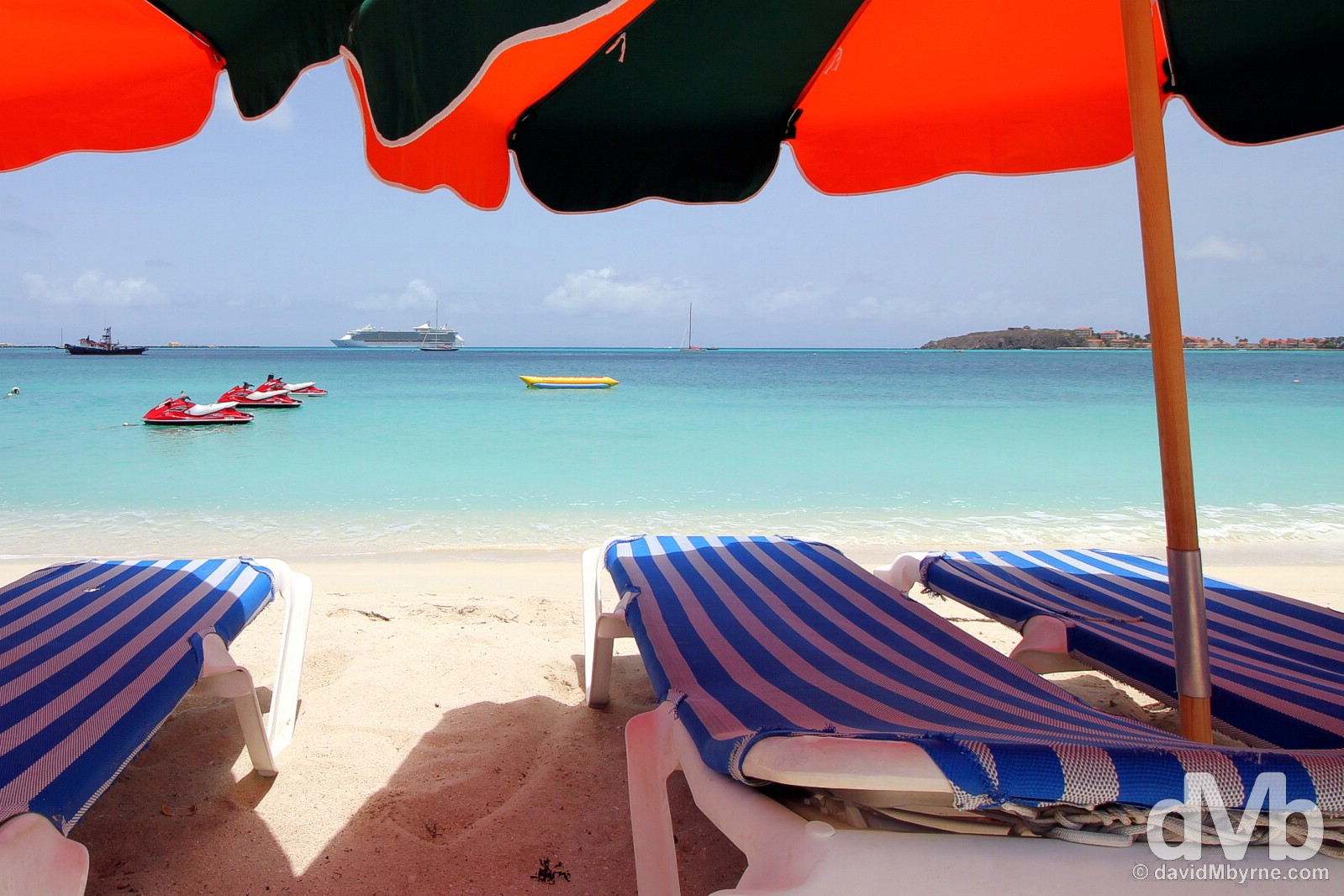
The arc of golden sand fronting Philipsburg’s pedestrianised Boardwalk is rather inviting, itself fronting the calm azure waters of the island’s sheltered Great Bay – it’s brochure-esque picture-perfect Caribbean. It’s also busy, although not now, noon on a Monday, when most are probably still sleeping off last night’s hangover. In the distance is one of the massive cruise ships that make regular calls to Philipsburg’s cruise terminal, one of the most popular in the Caribbean (the French side doesn’t have a cruise ship terminal). Most cruisers spend their time on land flashing their credit cards in the town’s duty-free shops or being whisked the 14 kilometres to Maho Beach to watch the world-famous spectacle of planes landing & taking-off from the island’s Princess Juliana International Airport. Philipsburg, Sint Maarten, Lesser Antilles. June 8, 2015.
A Caribbean Tourism Trendsetter
In much of the Caribbean tourism took root as a result of World War II. Nowhere is this more apparent than here in Sint Maarten. In 1930 the population of the island stood at just 2,000. Things changed in 1943 when the US Navy built large runways on the islands of the region as part of a Caribbean base, runways used ever since to fly in tourists. (Similar port infrastructure left behind by the US also proved useful when the cruise and package-holiday business got going in the 1950s.) On this particular island the Dutch realised the tourism potential from the get-go; they began focusing on tourism in the 1950s (the French side followed suit two decades later) and by the late 1950s the island’s population had ballooned to 70,000. Today tourism remains, and as it is on many Caribbean islands, the number one industry, some say the only industry – of the present-day population of 80,000, it is estimated that approximately 85% are engaged in the tourism industry.
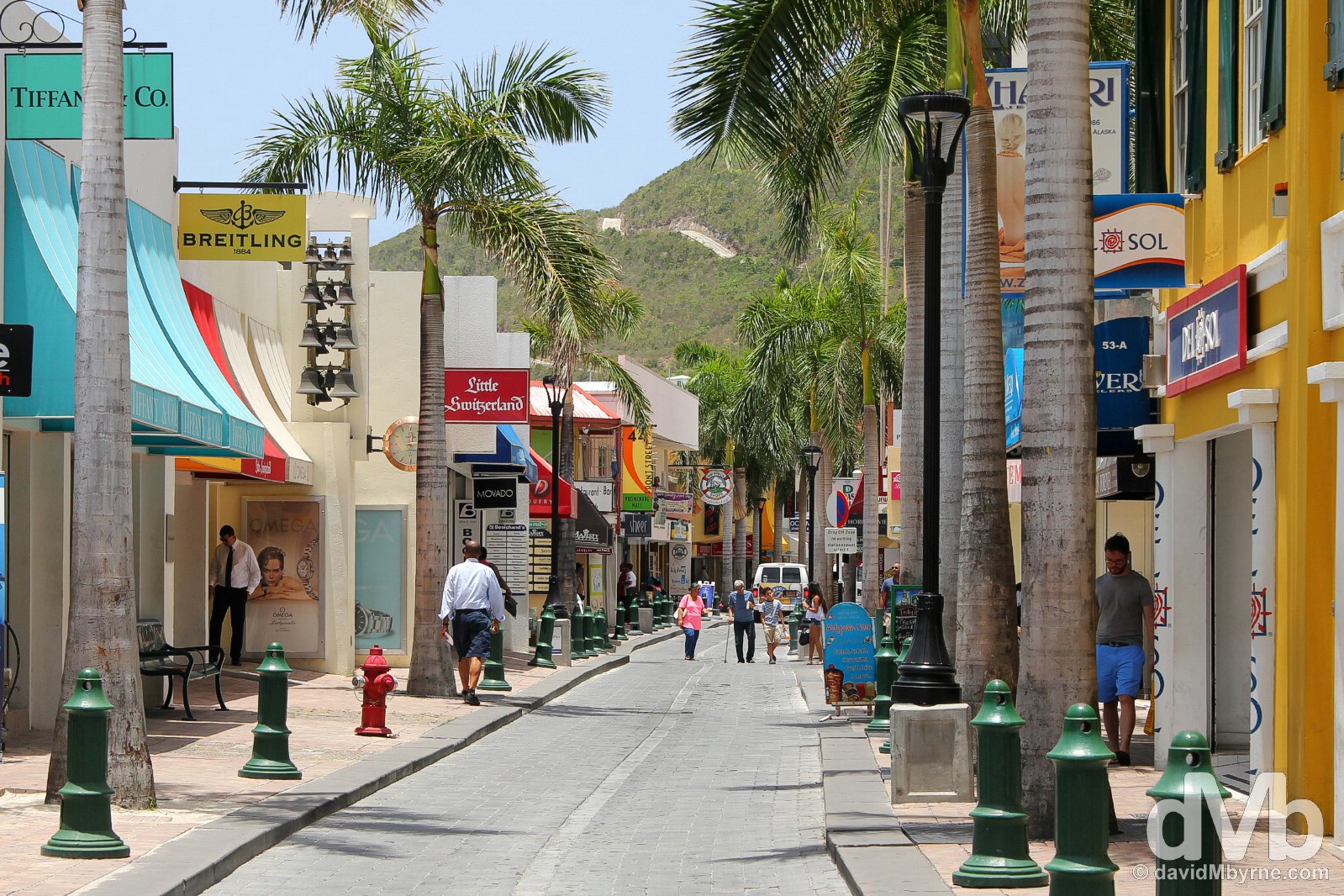
A section of Front Street, duty-free nirvana in Philipsburg and the heart of the town. I succumbed here, not intending to. My wide-angle lens had been out of commission since Grand Cayman almost a month previous. Investigating prices to replace it meant it impossible not to do so; competition is stiff so prices are good. Very good. I left the store with the new lens attached, destination Maho Beach. Philipsburg, Sint Maarten, Lesser Antilles. June 8, 2015.
Maho Beach – An Awesome Aviation Adventure
Yes, I took a quick look around Marigot & Philipsburg but for me this particular Caribbean location was always going to be about its world-famous aeronautical attraction, the approach to the island’s small Princess Juliana International Airport, voted best airport in the Caribbean 2016 by Caribbean Journal. Maybe there are better plane-spotting locations elsewhere on planet earth (I’m not a connoisseur of such endeavours) but there are surely none as iconic nor as intimate as the deafening, hair-raising antics of the massive jets – and smaller ones too – as they come in to land seemingly within touching distance of those on the sands of Sint Maarten’s Maho Beach.
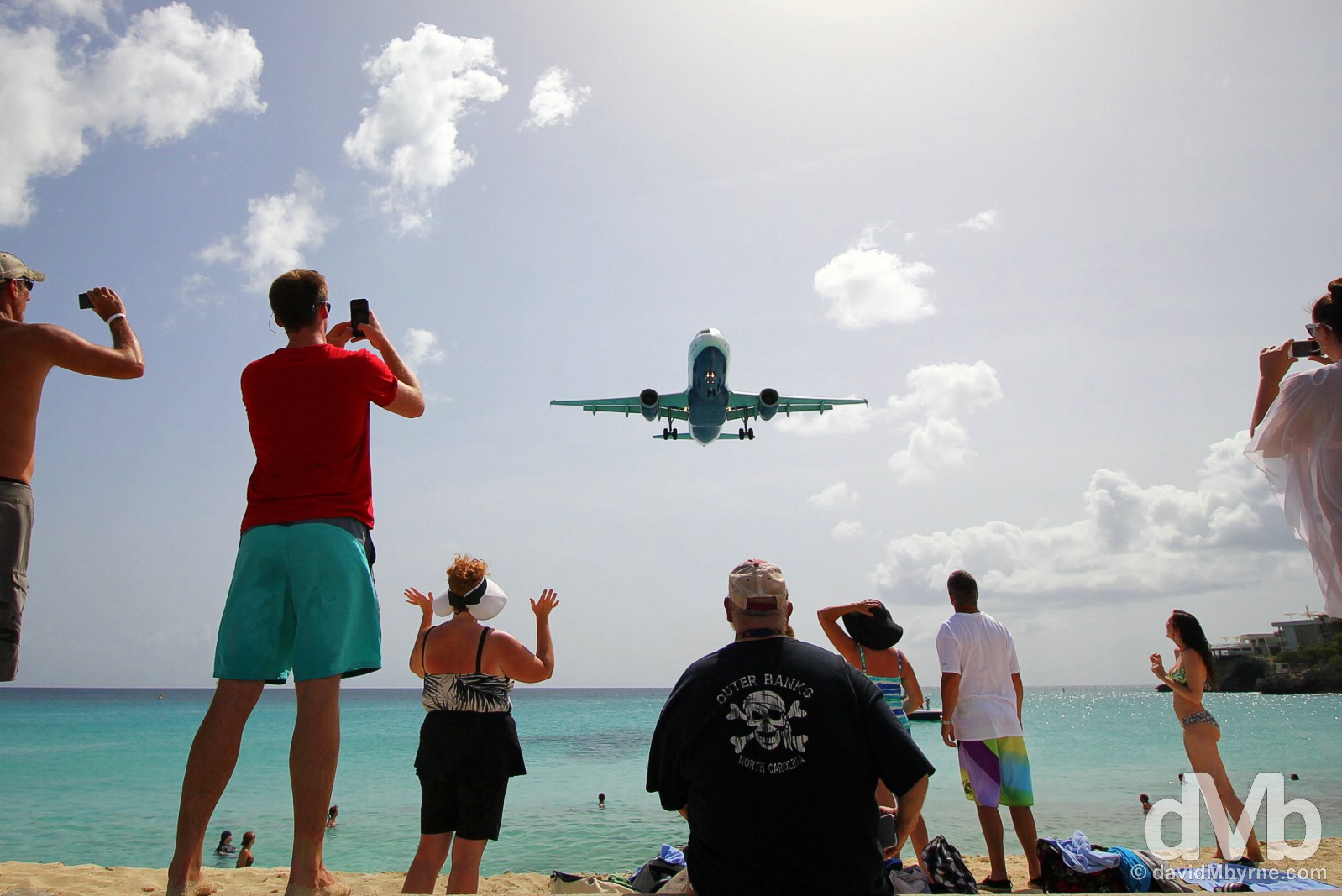
A welcome party on Maho Beach of Maho Bay, Sint Maarten, Lesser Antilles. June 8, 2015.
The majority of the daylight hours I spent on the island saw me hanging out on Maho Beach. Armed with take-off & landing times, I just waited.
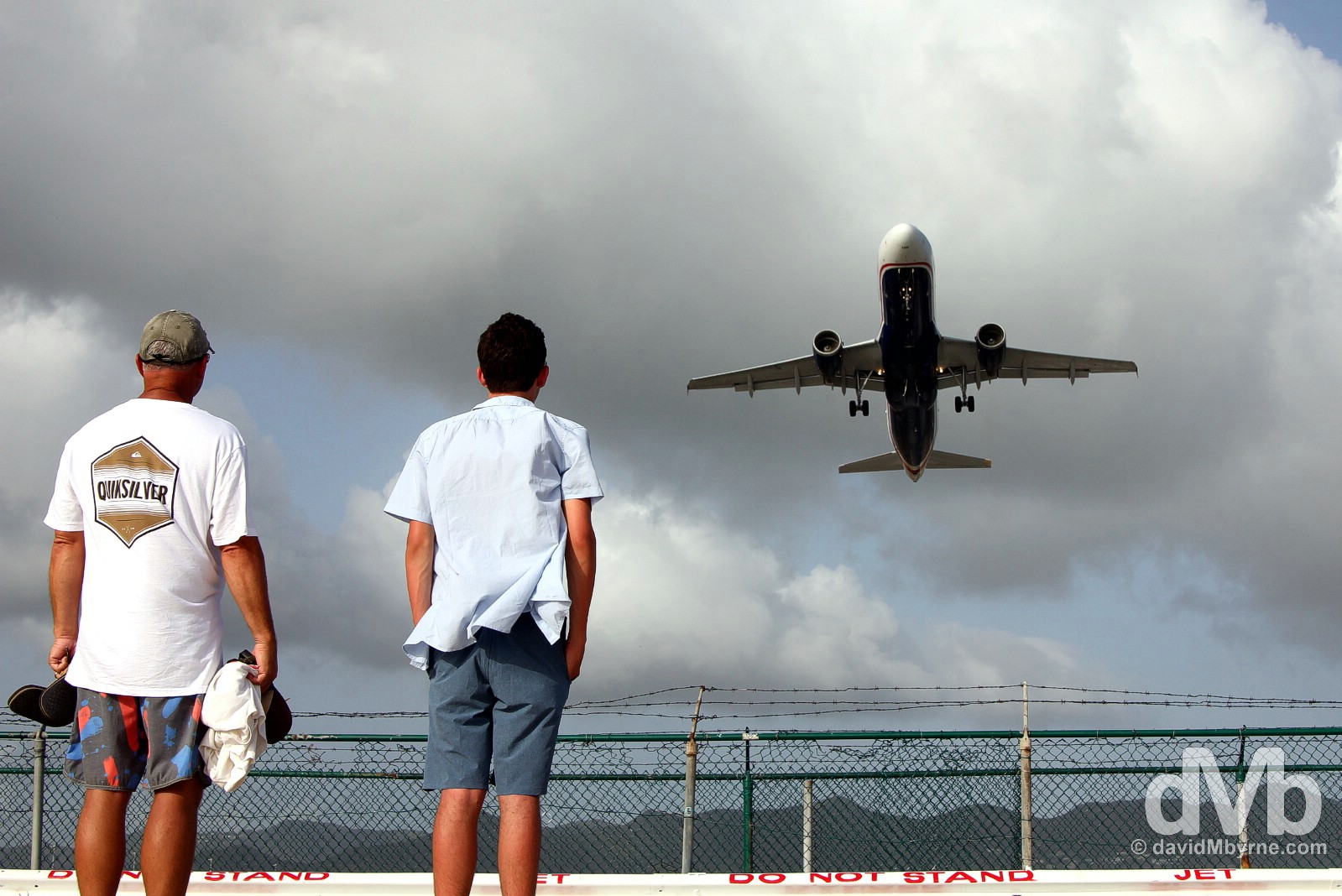
DAY 1 – 16:41 I arrived on the island from Puerto Rico on a Sunday afternoon. It was mostly overcast and dare I say a tad chilly. It was a slow Sunday with not too many flights either landing or departing. This picture of a jet departing was the very first jet I witnessed either arriving or departing the island. It was also to prove to be the only plane, jet or otherwise, over the course of the three days I was here that took-off over the beach – every other plane took-off from the beach end of the runway, enabling those daring enough to ‘Ride the Fence’ (see later pictures). Maho Beach, Sint Maarten, Lesser Antilles. June 7, 2015.
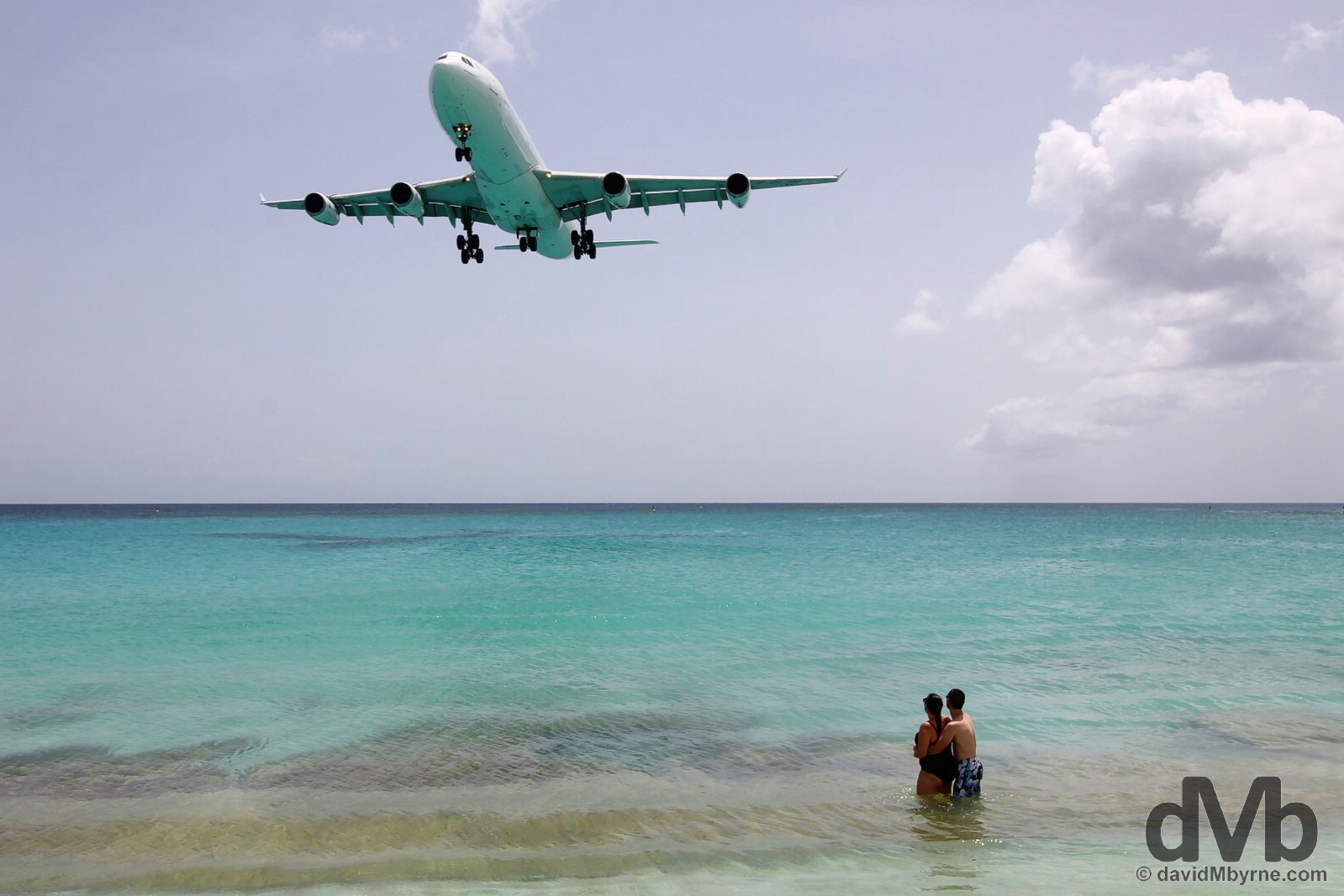
Day 2 – 13:40 An Air France A340 from Paris Charles de Gaulle approaching Princess Juliana International Airport as viewed from the warm waters of Maho Bay, Sint Maarten, Lesser Antilles. June 8, 2015.

Day 2 – 13:45 Five minutes later and it’s the turn of an American Airlines jet to get everyone’s attention. On the sands of Maho Beach, Sint Maarten, Lesser Antilles. June 8, 2015.
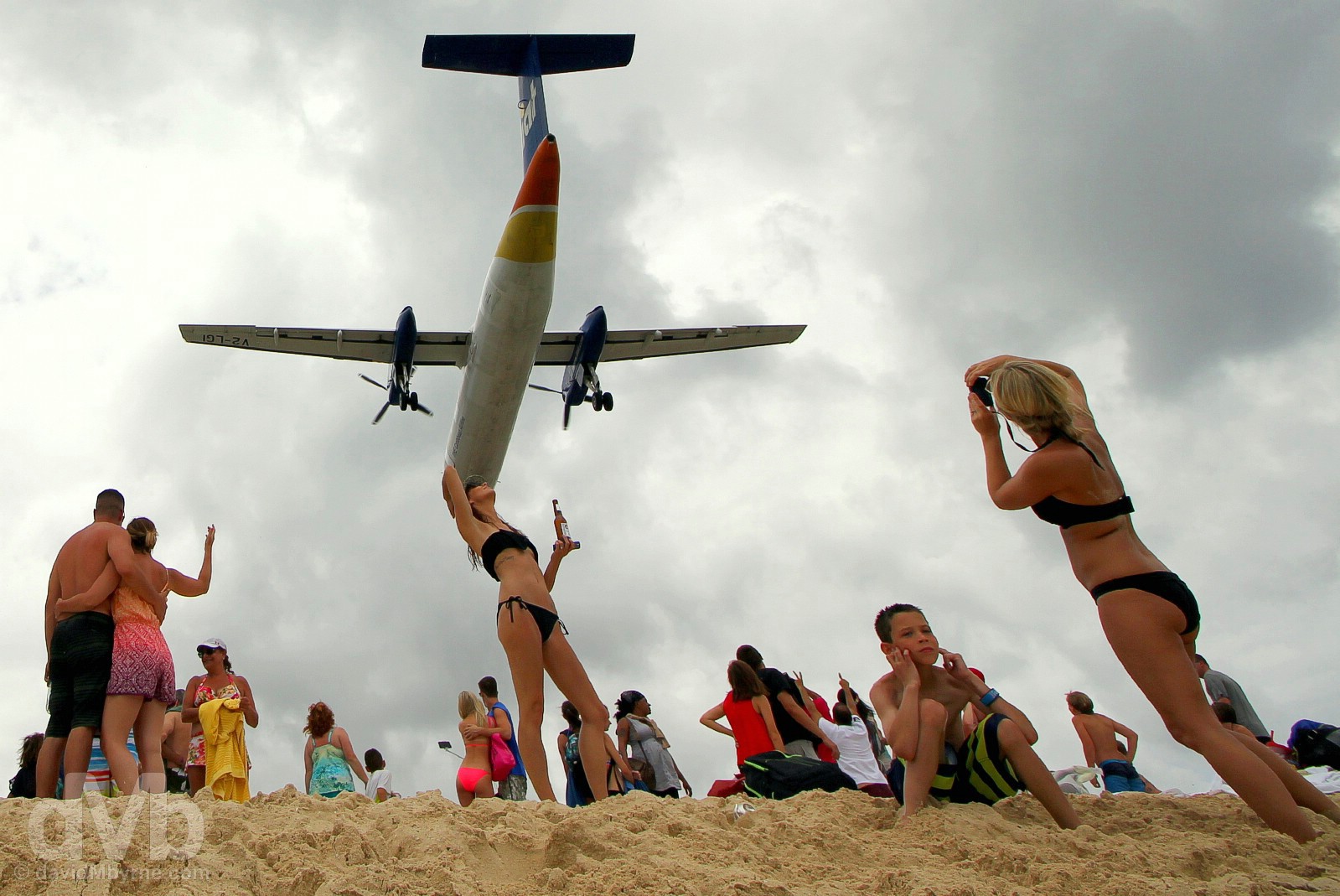
Day 3 – 12:04 Day 3, my last day on the island, started out nice but got overcast in a Caribbean hurry. But that didn’t stop the crowds or the noise, even the smaller twin-props causing a racket. An approach to Juliana Airport over the sands of Maho Beach, Sint Maarten, Lesser Antilles. June 9, 2015.
Riding The Fence
Maho Beach isn’t just about the thrill of the big jets. It’s about the challenge they provide, too.
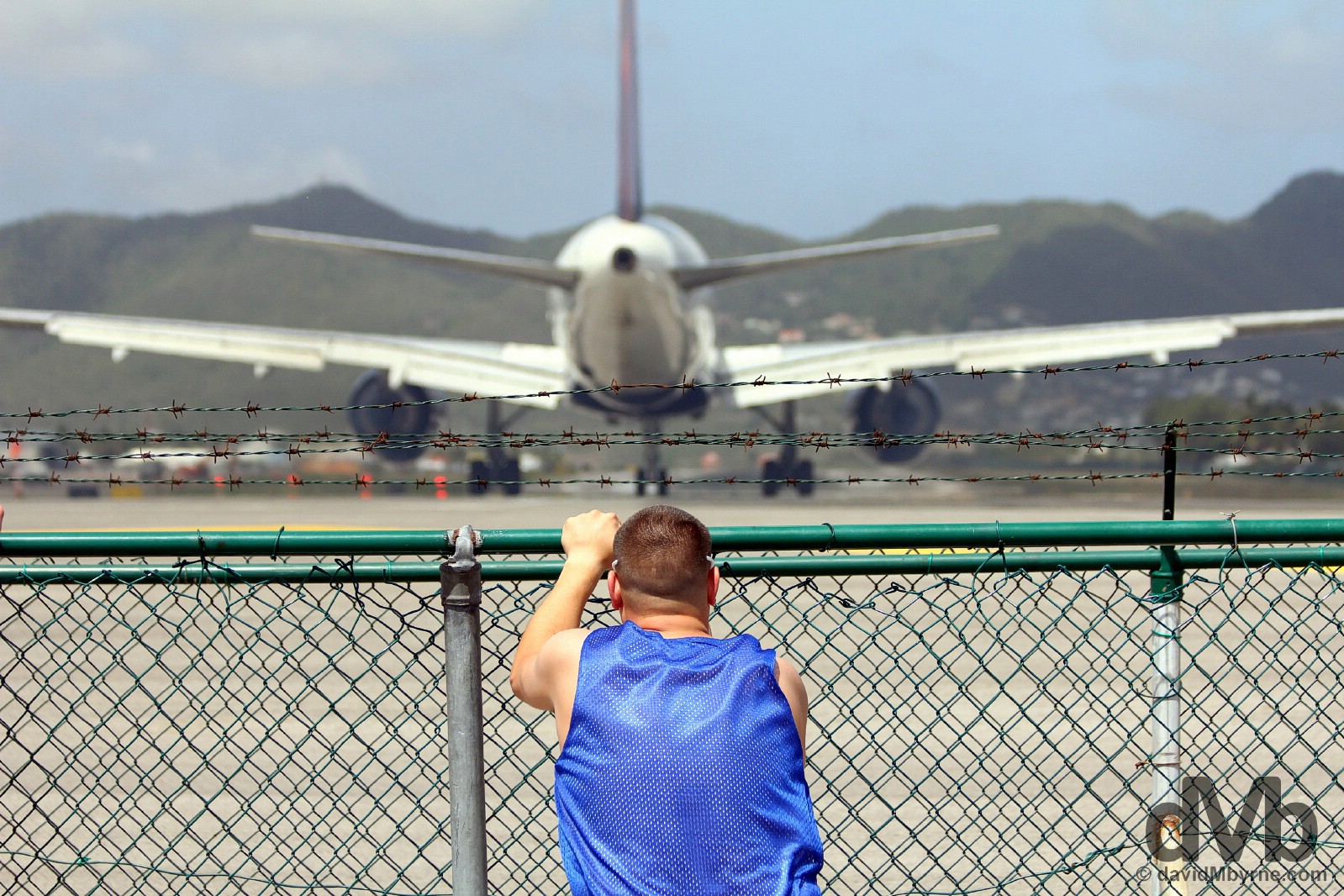
Day 2 – 14:14 Riding The Fence – trying to cling to a small fence as the full force of modern-day jet engines scream at you from unhealthy distances (50 metres/160 feet, give or take). It’s a challenge, make no mistake. Some say it’s dangerous. Some even claim it a foolish undertaking. It is, on both counts. Even small jets pack a punch so the power of something like the wide-bodied jet seen here was incredible, and scary at the same time. As a Maho Beach virgin, you stand there in anticipation not really knowing what to expect and severely underestimating the blast to come. Only then, when it’s too late, do you quickly understand, scramble into damage limitation mode and attempt to seek shelter where there is none. I was, and if you’ll pardon the oh-so-obvious pun, blown away, as were my sunglasses; they were were lifted right off my head to land some distance behind me in the waves. And I wasn’t even riding the fence (and nor did I ever), happy instead to attempt to photograph from the wings those brave or stupid enough to give it a go. This image was captured just prior to the the engines hitting full force. At that stage photography was/is impossible. Maho Bay, Sint Maarten, Lesser Antilles. June 8, 2015.
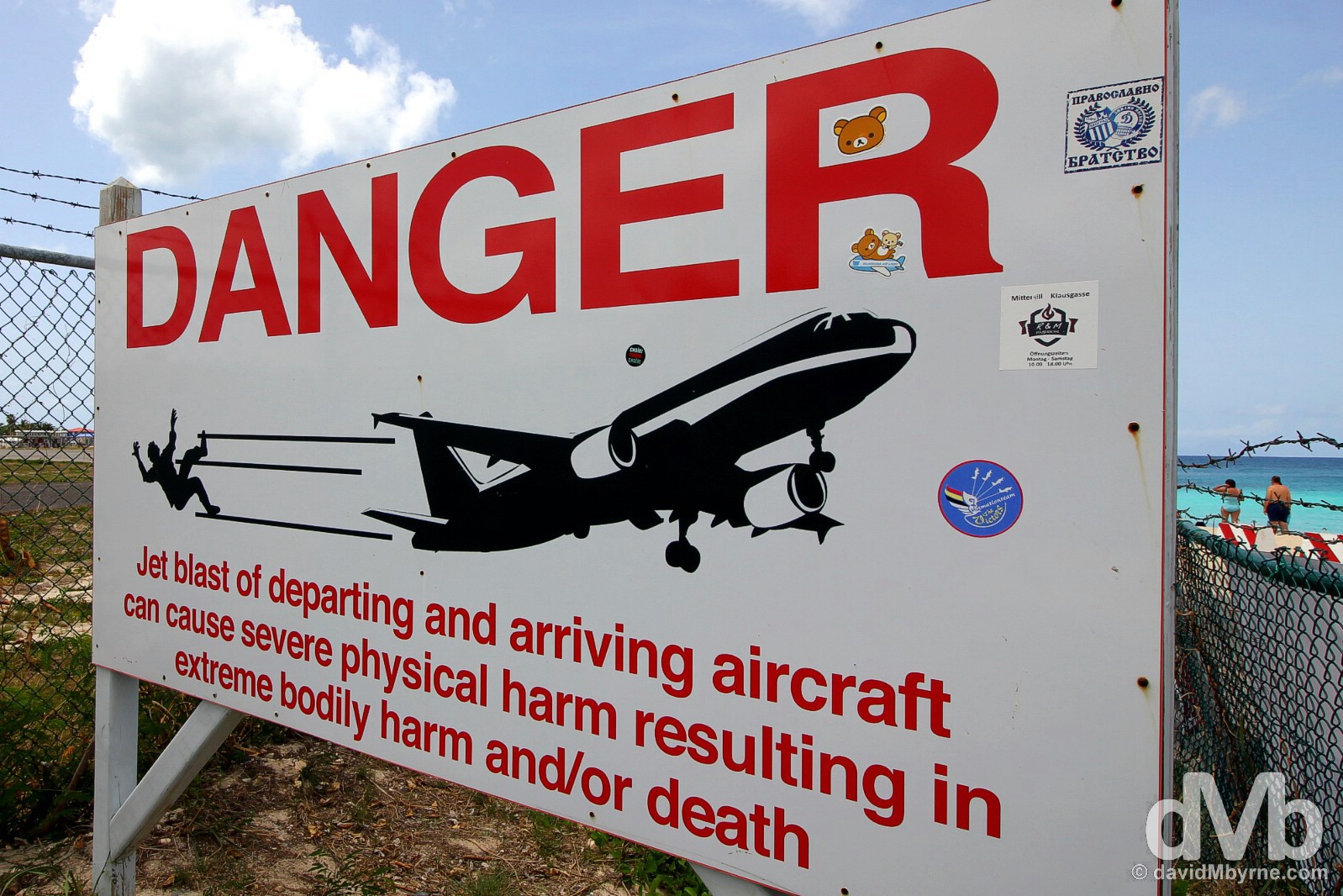
Danger indeed (UPDATE: This is no idle threat. A tourist was killed in July 2017). Signage abound at Maho Bay, Sint Maarten, Lesser Antilles. June 9, 2015.
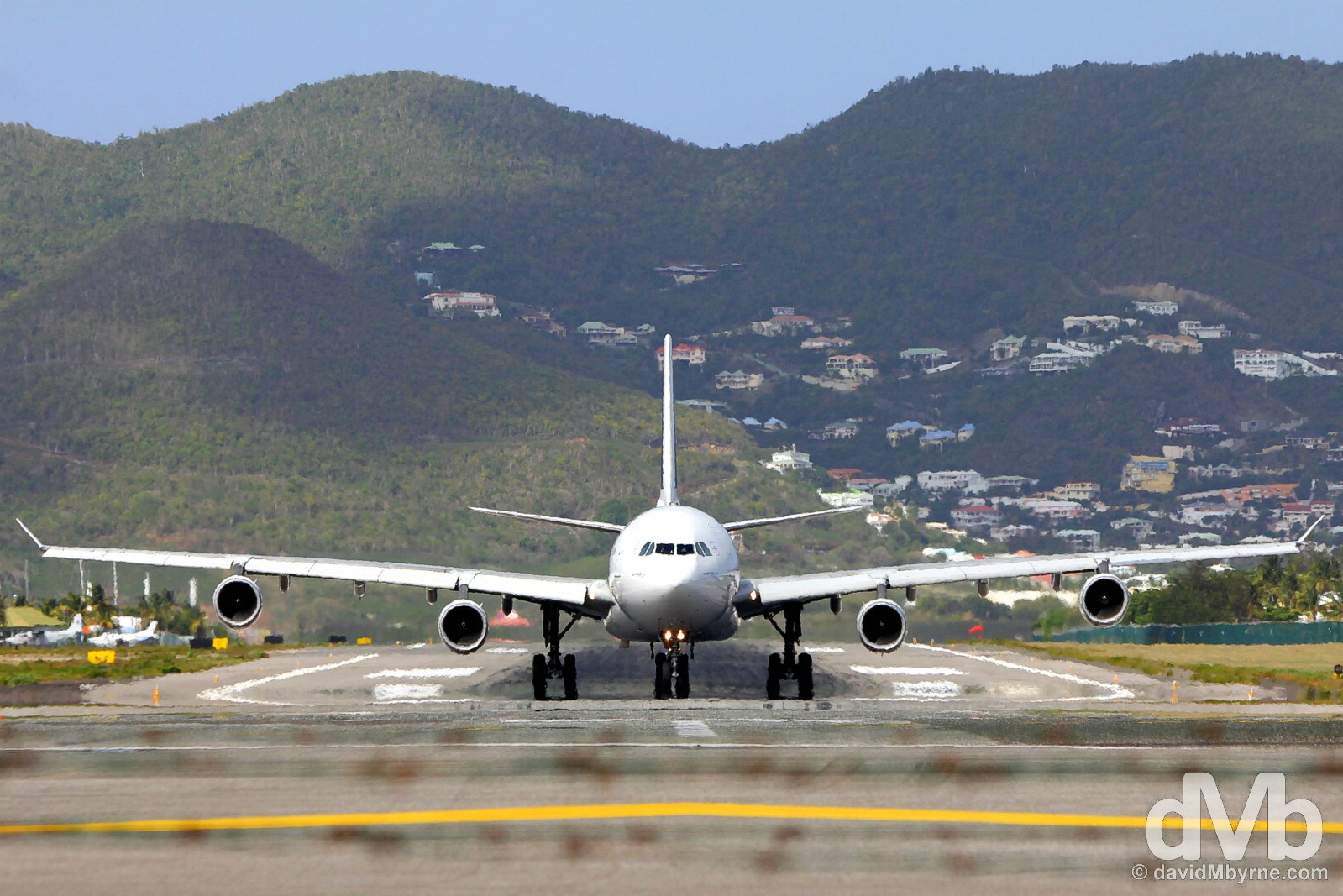
Day 2 – 15:55 There were a few big birds scheduled to excite on day 2. All arrived and departed on time. The biggest jet to land (& take-off) in my presence on this day was this four-engine, wide-body Air France A340. Having seen it glide in at 13:40, it was ready to go again some 2 hours later, its full 60-metre-wide wingspan seen here as it was taxiing through the heat shimmer towards the end of the runway. There it would turn, stall, open the throttle and accelerate back whence they came, all only metres from those observing from the sands of Maho Beach or those clinging valiantly to its fence. Having experienced the power of the previous jet I stayed well out of harm’s way for this big boy’s au revoir as it embarked on its return to Paris Charles de Gaulle. Princess Juliana International Airport, Sint Maarten, Lesser Antilles. June 8, 2015.
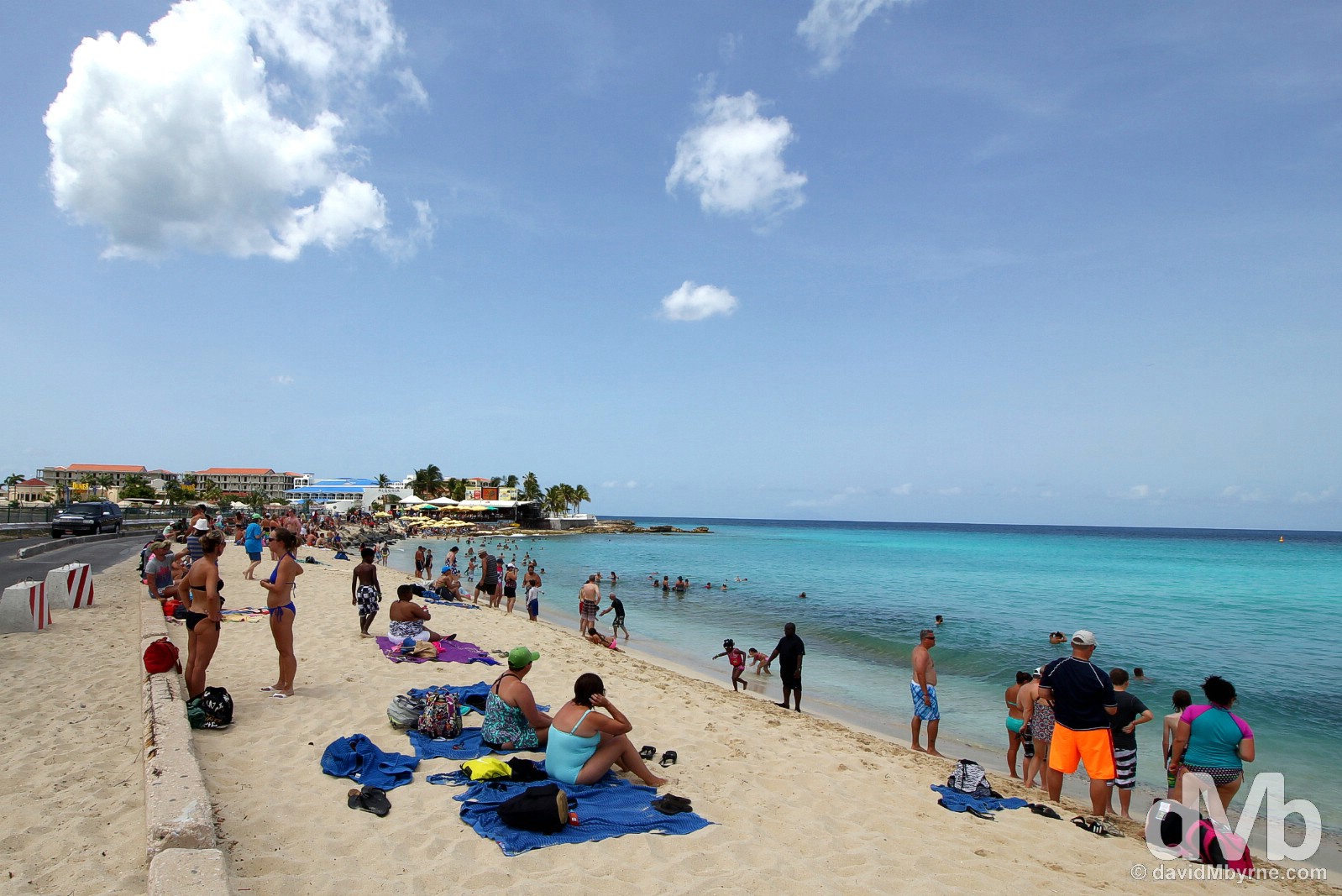
Day 3 – 10:49 Some days on Maho Bay’s small Maho Beach were busier than others. The crowds varied throughout the day as well. Even without a timetable to reference, you’d know when a big bird was scheduled to land; the crowds would grow (dido for when a cruise ship is docked in Philipsburg’s port). Seen here is the small road that separates the beach, which boasts quite the fall down to the water, from the runway fence (cars wisely stop when big jets are taking-off). In the distance, at the far end of the beach, is the Sunset Bar & Grill, a pumping every-hour-is-happy-hour bar with an airline-themed menu; I hear the KLM Pizzas in particular fly out of the kitchen. Boom boom. Maho Beach of Maho Bay, Sint Maarten, Lesser Antilles. June 9, 2015.
Big Bird
The beach was especially busy on my last day on the island. An iconic Boeing 747 was due to land and take-off, a big deal in these parts. Due to land at 11 a.m., the KLM flight from Amsterdam arrived an hour early meaning that, and I’m ashamed to admit, I missed the landing. But I was there for the taxiing & attempted take-off, as were many, many others. The so-called Queen of the Skies can certainly pull the crowds. UPDATE: Damn. As of October 2016, the 747 no longer serves the island. Yes, it’s the End of the World’s Coolest Landing.
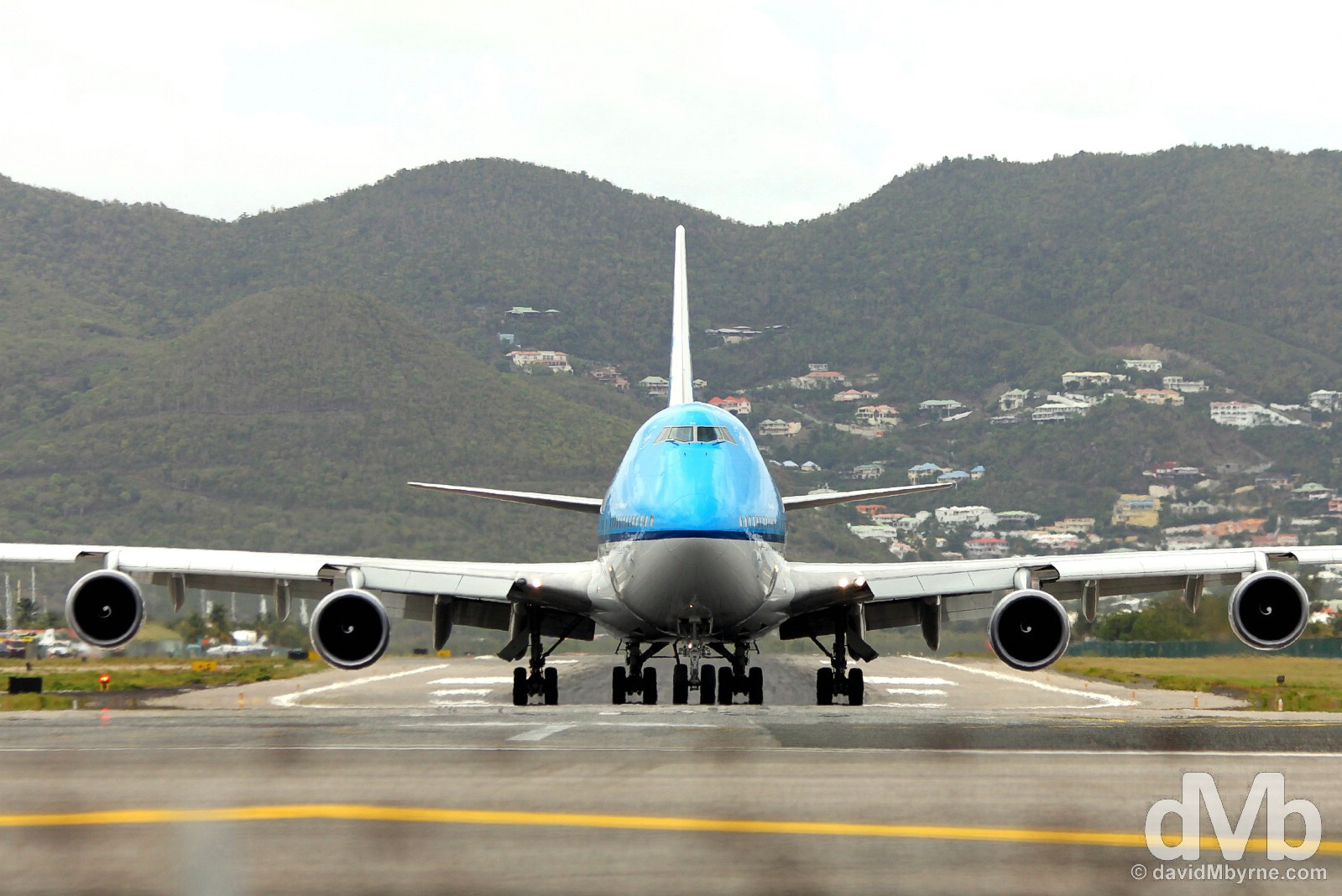
Day 3 – 11:56 Be scared. The island’s Juliana airport only has one runway with a single entry/exit halfway down. As a result, all planes must taxi to one end of the runway for take-off, more often than not from the western, Maho Bay/spectator end of the 2.3 kilometre-long runway, just as this 747 is in the process of doing. A KLM 747 taxiing for take-off at Juliana International Airport, Sint Maarten, Lesser Antilles. June 9, 2015.
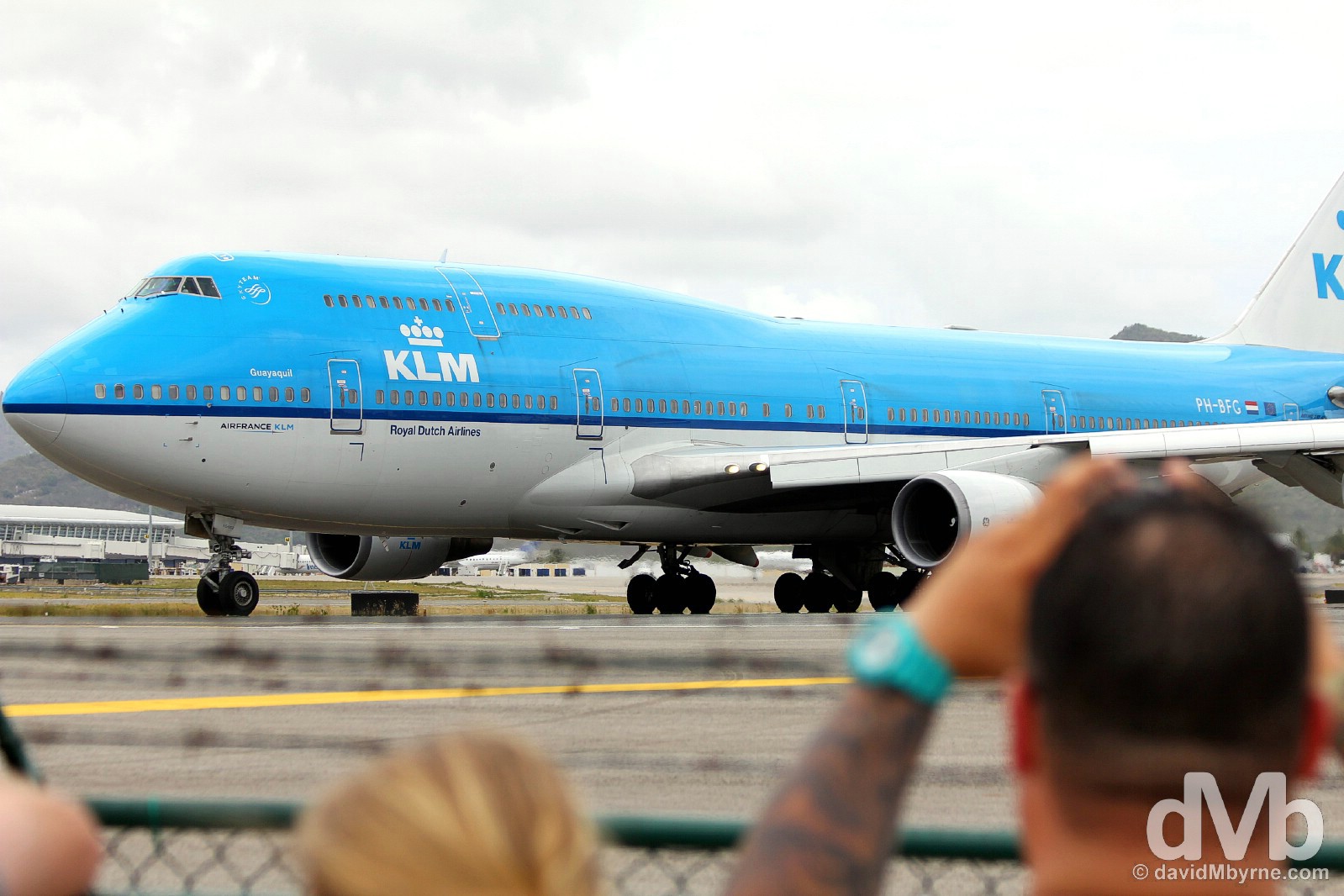
Day 3 – 11:58 Oh the power. The rumble of this beast taxiing towards us was astonishing. Growing ever bigger, ever more intimidating, it felt like it was going to roll right over us before sharply turning and straightening up to accelerate. We even got acknowledgments from the crew in the cockpit who’ve no doubt seen this all before, fully aware of the carnage they are about to unleash. A KLM 747 taxiing for take-off at Juliana International Airport, Sint Maarten, Lesser Antilles. June 9, 2015.
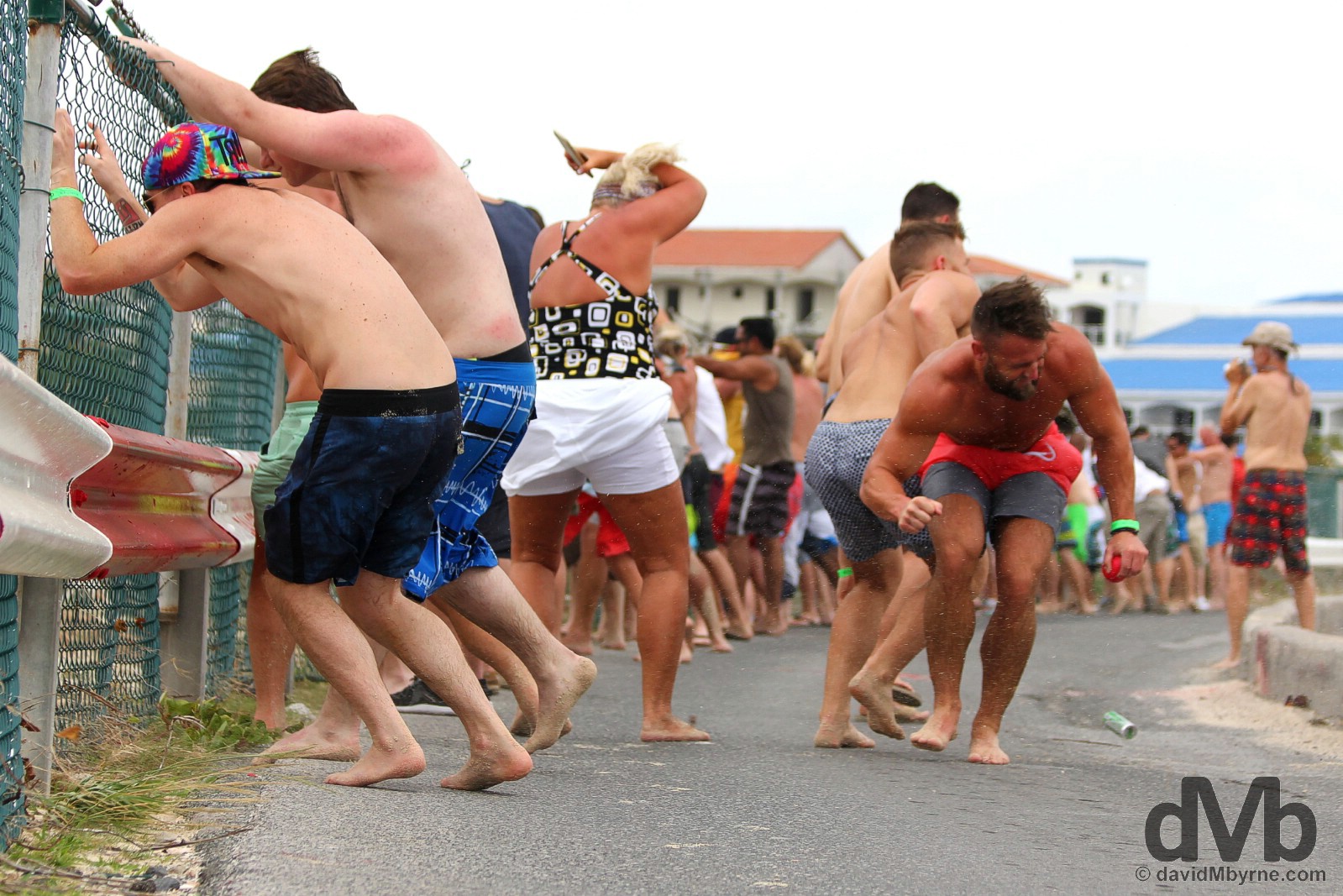
Day 3 – 11:57 Riding The Fence, 747 style. Again I stayed out of the obvious danger zone, the area directly behind the 747’s 60-metre wingspan. Plus, I attempted to shelter my camera behind the crash barrier, the one liberally adorned with red ‘Do Not Stand Jet’ lettering. Even so, I could only stay in photographer mode for so long before curling into a roadside ball to wait out the worst of the storm. The 747 unleashed all it had – some of the uninitiated or ill-prepared in attendance were blown over – and started to accelerate down the runway. The noise. The power. The mayhem. But then inexplicably the engines pulled back, the 747 rolled to a stop and all was silent, save for those recovering on Maho Beach, elated to still be in one piece and searching out personal items blown into the waters behind them. The 747 just sat there halfway down the runway, something obviously amiss. It eventually stirred & limped back to the terminal. Everyone was expecting a repeat performance but no – the 747 was still terminal-bound some 4 hours later when I was boarding a rickety twin-prop plane to my next Caribbean destination, the Lesser Antilles island of Dominica further south. I never did discover what happened to that 747. Maho Bay, Sint Maarten, Lesser Antilles. June 9, 2015.
Video – Big Plane, Short Runway
This is an awesome look at the KLM flight from Amsterdam to Sint Maarten courtesy of KLM themselves.
I took video of the shenanigans on Maho Beach but YouTube is awash with similar efforts much better than mine. Here is a good look at the some Maho Beach goings-on, including a take-off of the very same City of Guayaquil KLM 747 seen here. I don’t blame the guy with the camera for running out of harm’s way.
